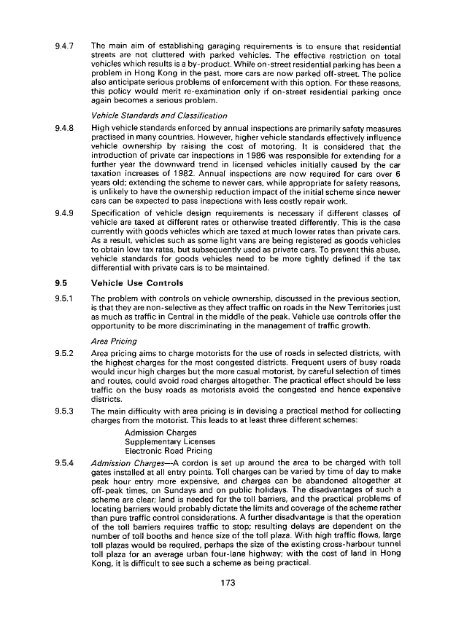Untitled - HKU Libraries - The University of Hong Kong
Untitled - HKU Libraries - The University of Hong Kong
Untitled - HKU Libraries - The University of Hong Kong
- No tags were found...
You also want an ePaper? Increase the reach of your titles
YUMPU automatically turns print PDFs into web optimized ePapers that Google loves.
9.4.7 <strong>The</strong> main asm <strong>of</strong> establishing garaging requirements is to ensure that residentialstreets are not cluttered with parked vehicles. <strong>The</strong> effective restriction on totalvehicles which results is a by-product. While on-street residential parking has been aproblem in <strong>Hong</strong> <strong>Kong</strong> in the past more cars are now parked <strong>of</strong>f-street. <strong>The</strong> policealso anticipate serious problems <strong>of</strong> enforcement with this option. For these reasons,this policy would merit re-examination only if on~street residential parking onceagain becomes a serious problem.Vehicle Standards and Classification9.4.8 High vehicle standards enforced by annual inspections are primarily safety measurespractised in many countries. However, higher vehicle standards effectively influencevehicle ownership by raising the cost <strong>of</strong> motoring. It is considered that theintroduction <strong>of</strong> private car inspections in 1986 was responsible for extending for afurther year the downward trend in licensed vehicles initially caused by the cartaxation increases <strong>of</strong> 1982. Annual inspections are now required for cars over 6years old; extending the scheme to newer cars, while appropriate for safety reasons,is unlikely to have the ownership reduction impact <strong>of</strong> the initial scheme since newercars can be expected to pass inspections with less costly repair work.9.4.9 Specification <strong>of</strong> vehicle design requirements is necessary if different classes <strong>of</strong>vehicle are taxed at different rates or otherwise treated differently. This is the casecurrently with goods vehicles which are taxed at much lower rates than private cars.As a result, vehicles such as some light vans are being registered as goods vehiclesto obtain low tax rates, but subsequently used as private cars. To prevent this abuse,vehicle standards for goods vehicles need to be more tightly defined if the taxdifferential with private cars is to be maintained.9.5 Vehicle Use Controls9.5.1 <strong>The</strong> problem with controls on vehicle ownership, discussed in the previous section,is that they are non-selective as they affect traffic on roads in the New Territories justas much as traffic in Central in the middle <strong>of</strong> the peak. Vehicle use controls <strong>of</strong>fer theopportunity to be more discriminating in the management <strong>of</strong> traffic growth.Area Pricing9.5.2 Area pricing aims to charge motorists for the use <strong>of</strong> roads in selected districts, withthe highest charges for the most congested districts. Frequent users <strong>of</strong> busy roadswould incur high charges but the more casual motorist, by careful selection <strong>of</strong> timesand routes, could avoid road charges altogether. <strong>The</strong> practical effect should be lesstraffic on the busy roads as motorists avoid the congested and hence expensivedistricts.9.5.3 <strong>The</strong> main difficulty with area pricing is in devising a practical method for collectingcharges from the motorist. This leads to at least three different schemes:Admission ChargesSupplementary LicensesElectronic Road Pricing9.5.4 Admission Charges—A cordon is set up around the area to be charged with tollgates installed at all entry points. Toll charges can be varied by time <strong>of</strong> day to makepeak hour entry more expensive, and charges can be abandoned altogether at<strong>of</strong>f-peak times, on Sundays and on public holidays. <strong>The</strong> disadvantages <strong>of</strong> such ascheme are clear; land is needed for the toll barriers, and the practical problems <strong>of</strong>locating barriers would probably dictate the limits and coverage <strong>of</strong> the scheme ratherthan pure traffic control considerations. A further disadvantage is that the operation<strong>of</strong> the toll barriers requires traffic to stop; resulting delays are dependent on thenumber <strong>of</strong> toll booths and hence size <strong>of</strong> the toll plaza. With high traffic flows, largetoll plazas would be required, perhaps the size <strong>of</strong> the existing cross-harbour tunneltoll plaza for an average urban four-lane highway; with the cost <strong>of</strong> land in <strong>Hong</strong><strong>Kong</strong>, it is difficult to see such a scheme as being practical.173
















